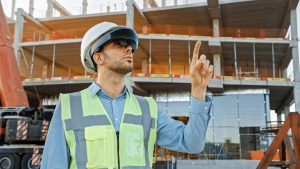A recent study on wearables and construction business safety reported, “The construction industry has long been regarded as one of the most dangerous industries worldwide. It employs approximately 7% of the global workforce but contributes to 30-40% of total fatalities.”
There are plenty of websites explaining how wearables can increase construction safety but it will be years before we can say it’s been proven. There’s no data – yet – to support predictions, including the forecast that owners/operators of construction companies are ready to buy into wearable technology. However, employees may balk.
Construction Business Hazards & Wearables: Big Brother?
Wearable technologies require high adherence and commitment from the user.
–National Library of Medicine
The first concern of construction business employees is invasion of privacy. “Is Big Brother watching us?” They wanted to know if the wearables monitored standing still too long, recorded conversations, or videotaped construction activity.
Physical overexertion causes 35% of all work-related injuries. Strains, sprains, and muscle/tendon tears from improper lifting, posture, and movement are ergonomic injuries that wearables train employees to avoid.
One wearable technology can identify high-risk movements in real-time and trigger an alert. The user must then self-correct. It does not “secretly” monitor anything else.
What it does do is create a competition between the wearable and the user. It sets safety goals and then challenges its wearer to meet those goals. It uses real-time feedback and gamification to further engage users.
For project managers, the information is valuable: One user had higher risk movements than most. Upon investigation, the supervisor learned the individual had knee difficulties and the wearable triggered a warning when bending to retrieve items from the parts bin. A workstation redesign solved the problem and the removed potential for future injury.
Another valuable benefit is wearables give voice to employee concerns. A manager is alerted to a risk activity. Upon investigation, the employee – who would never have complained – explained how he had been cutting corners to get a job completed within a certain amount of time.
Users find that wearables influence the way they do things at home as well. They tackle home improvement tasks differently because they now know strategies to work safer.
Construction Monitor strives to be a valued source of safety information in addition to being the top source for construction business development in the United States. If you have marketing questions, let us know. We’ll have answers and possible solutions. Call 435-586-1205 or contact Construction Monitor.

